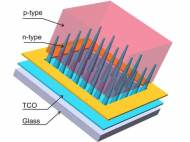New 3D nanocone solar cell technology boosts the efficiency
 A team of researchers, led by Oak Ridge National Laboratory’s (ORNL’s) Jun Xu, created a 3D nanocone-based solar cell platform which boosts the light-to-power conversion efficiency of photovoltaics by nearly 80 percent. The technology substantially overcomes the problem of poor transport of charges generated by solar photons, which occur due to defects in bulk materials and their interfaces and degrade performance.
A team of researchers, led by Oak Ridge National Laboratory’s (ORNL’s) Jun Xu, created a 3D nanocone-based solar cell platform which boosts the light-to-power conversion efficiency of photovoltaics by nearly 80 percent. The technology substantially overcomes the problem of poor transport of charges generated by solar photons, which occur due to defects in bulk materials and their interfaces and degrade performance.
“To solve the entrapment problems that reduce solar cell efficiency, we created a nanocone-based solar cell, invented methods to synthesize these cells and demonstrated improved charge collection efficiency”, said Xu, a member of ORNL’s Chemical Sciences Division.
The new solar structure consists of N-type nanocones surrounded by a P-type semiconductor. The N-type nanoncones are made of zinc-oxide and serve as the junction framework and the electron conductor. The P-type matrix is made of polycrystalline cadmium telluride and serves as the primary photon absorber medium and hole conductor.
With this approach at the laboratory scale, Xu and colleagues were able to obtain a light-to-power conversion efficiency of 3.2 percent compared to 1.8 percent efficiency of conventional planar structure of the same materials.
“We designed the three-dimensional structure to provide an intrinsic electric field distribution that promotes efficient charge transport and high efficiency in converting energy from sunlight into electricity”, said Xu.
The minimization of defects and voids in semiconductors, enables unique electric field distribution that achieves efficient charge transport. Because of efficient charge transport, the new solar cell can tolerate defective materials and reduce cost in fabricating next-generation solar cells.
“The important concept behind our invention is that the nanocone shape generates a high electric field in the vicinity of the tip junction, effectively separating, injecting and collecting minority carriers, resulting in a higher efficiency than that of a conventional planar cell made with the same materials”, said Xu.
The papers are titled “Efficient Charge Transport in Nanocone Tip-Film Solar Cells” and “Nanojunction solar cells based on polycrystalline CdTe films grown on ZnO nanocones.”









Leave your response!